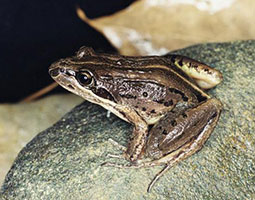Limnodynastes peronii
Description

The Striped Marsh Frog (Limnodynastes peronii) is one of the most common frogs in Eastern Australia. They have smooth skin adorned with dark and light brown longitudinal stripes, and a light brown to grey-brown pointed snout.
Striped Marsh Frogs are usually found near still water and are most active at night (nocturnal). During the day they prefer to shelter in leaf litter or under rocks and logs.
Breeding occurs from August to March. Males produce a ‘toc’ sound to attract females. Small, brown eggs are laid in a white foamy mass (frogspawn) on the surface of the water, with the tadpoles hatching a few days later.
Adaptations
- Males call while almost totally submerged which makes them less vulnerable to predators
- Excellent camouflage allows it to hide amongst wetland grasses and sedges
- Adult Males are generally 48-69mm in size; females are slightly larger at 46-73mm
- A veracious predator, it will eat almost anything it can fit in its mouth.
Feeding relationships
- What I eat: Living insects and other invertebrates (e.g. spiders)
- What eats me: Frogspawn is eaten by ants, fish, small lizards and birds. Tadpoles are eaten by pond fish, birds, water spiders, and water bugs (e.g. dragonfly larvae). Adult frogs are eaten by snakes, birds (e.g. kookaburra, butcher bird, magpie), bats, goannas, rats, other frogs, cane toads, fish and domestic pets.
Interesting facts
Frogs are sometimes known as environmental indicators because they breathe through their skin. As a result, air and water pollution can cause a reduction or extinction of local frog populations.